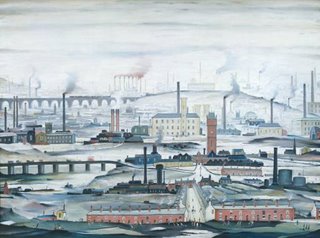Artists: L.S. Lowry

My father grew up in Salford, in Lancashire, part of greater Manchester. He was born in 1909 and spent his childhood in poverty and hardship. Times were hard back then, but when he spoke of his childhood it was always with affection. He would speak of the rough streets and the tough kids that he knew and loved and I would be homesick for a place and time that I would never know. He joined the British army in 1928 and spent 21 years serving his country. I met up with a man, many years later, who joined the army the same day as my dad, the same regiment. He said they both joined for the same reason...a new pair of boots.
L.S. Lowry, who painted the picture above called Industrial Landscape, came as quite a pleasant surprise to me. When I first returned to England, the land of my birth, it was to Manchester that I came. I had family there. My old aunt, who was aged and smoked 60 woodbines a day, introduced me to her parish priest soon after my arrival. He asked me what I thought of England. "A lot of bricks", I told him.
I found employment, as usual, washing dishes in a downtown restaurant. Split-shifts, being the norm for such employment, afforded me time to browse and loiter away the quiet hours between servings. Art galleries were free to wander, and it was there and then that I discovered Lowry.

This painting is called The Fever Van. An ambulance has arrived to cart away some unfortunate soul. But life goes on, and Lowry allows us to witness, with the curiosity of the passing strangers, an obviously not uncommon scene.
When I visited the Lowry Museum, in the early 1980's, I was first struck by the simple and somehow primitive style of his work. But as I wandered further I discovered that he was not an artist who was confined to a style. He was, as he demostrated often, capable of painting and drawing in the "classical" style. He sometimes did classical studies just to prove that he could. The museum, at that time confined to an upstairs room in the public library, was filled with works that resembled and equaled the life drawings of the old masters. But in his "matchstick" style he found that peculiar expression that brought him recognition and deserved gratitude.
Lowry ( 1887-1976) worked as a clerk until he retired at the age of 65. He spent his free time studying art and painting. He was exhibiting his art in Manchester from the 1920's and was drawing serious attention by the 1940's. His bleak industrial townscapes captured the soul of industrial Britain in its' harshest days. The seemingly endless smokestacks and bricks, peopled by the anonymous matchstick masses going about their daily proletarian life, captured with an almost musical and comedic simplicity, was his gift to us. His pallet was, if not dark, filled with the cold of winter, the colour of brick, and the polluted air of coal-driven industry. But his canvasses were nothing if not human. His people, although matchstick-like and anonymous, triumphed the humanity seething between the bricks and the smokestacks.
And my dad was one of them.


0 Comments:
Post a Comment
<< Home